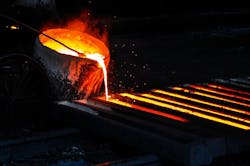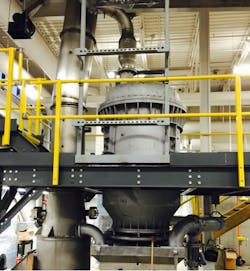The U.S. relies on the production of steel for any number of applications, as it is the material of choice for construction, manufacturing, transportation, appliances, and a wide range of other areas. According to a report from the World Steel Association, world steel production topped out at 1,691 million tons and is expected to nearly double that production by 2050. Last year alone, the U.S. produced 81.6 million metric tons of the alloy, and that number will continue to rise over the coming decades as demand for the material increases.
The modern methods for producing steel fall into two categories: Primary and Secondary. The first involves converting liquid iron from a blast furnace, basic oxygen steel making (reducing scrap metal into molten iron), and direct reduced iron (smelting in an electric arc furnace). The Secondary method revolves around refining crude steel with alloy agents added while being processed. Both ways have one thing in common: They are energy-intensive and use natural gas, coal/coke, or direct electricity to process the material.
This begs the question of exactly how much energy is used in the production of steel—not an easy question to answer, either. According to IEA (International Energy Association) estimates, the world’s total primary energy supply (TPES) amounted to 13,647 MTOE (Million Tonnes of Oil Equivalent) or the equivalent of around 18 TW per-year in 2015.
The OECD (Organization for Economic Co-operation and Development) reported that worldwide steel production consumed roughly 5% of the world’s energy supply in 2012—a significant portion, considering most energies went to residential services (36%), transportation (27%), and industrial use (23%). 9% went to non-energy applications).
While we’re on the numbers train: The U.S. relies heavily on coal and natural gas for steel production. As a result, manufacturers consumed an astounding 1.48 quadrillion BTUs to produce the metal during 2006, costing $6.69 billion for both heat and power while churning out 106 million short tons of steel per-year on average. This of course, is the culmination of the total energy required from mining the iron ore to its smelting and the tempering of alloys before the metal becomes available to the market. Those numbers may decline in the near future with advancements in new technologies.
The University of Utah’s Novel Flash Ironmaking Bench Reactor. (Image credit: University of Utah)
A new approach to producing steel from a collaboration between the American Iron and Steel Institute and the University of Utah may help reduce the amount of energy needed for manufacturing steel. Known as a Novel Flash Ironmaking Process, the technology would replace blast furnaces that require pelletization, iron ore sinterization, or coke making to produce steel, instead utilizing a method that produces iron directly from iron ore concentrates or powders.
This new approach uses gaseous reducing agents—such as hydrogen, natural gas, or even syngas (or a combination of them)—to flash heat a falling stream of iron ore particles in just a few seconds within a reaction chamber (pictured). The reactor design can be incorporated into existing production chains through the feed process, or else replace the blast furnace outright without the need for an extensive system overhaul. What’s more, beyond reducing energy consumption and costs, the system produces no CO2 emissions and doesn’t suffer from material solid-sticking or fusion.
Researchers from MIT have also been developing a cheaper, less-energy-intensive way to process steel through a process they term Molten Oxide Electrolysis (MOE)—a derivative of Molten Salt Electrolysis, a process that extracts metals from ore. To produce steel using the MOE method, iron oxide is heated through an electric current using an anode made of an alloy (comprised of chromium and iron), which travels through a pool of liquid iron and oxygen gas and produces steel as a byproduct. Although this method is only able to theoretically produce a few hundred thousand tons per year, it provides no carbon emissions—only oxygen.
While these new developments will not reduce the amount of energy needed to manufacture steel on a large scale, or the costs associated with them anytime soon, they represent what could become a possibility in the near future if new technology is continually developed for the industry. Certainly steel will never lose its appeal, as the perfect metal for industrial and construction applications. However, the way it’s processed is destined to change, and only for the better.
About the Author
Cabe Atwell
Technology Editor, Electronic Design
Cabe is a Technology Editor for Electronic Design.
Engineer, Machinist, Maker, Writer. A graduate Electrical Engineer actively plying his expertise in the industry and at his company, Gunhead. When not designing/building, he creates a steady torrent of projects and content in the media world. Many of his projects and articles are online at element14 & SolidSmack, industry-focused work at EETimes & EDN, and offbeat articles at Make Magazine. Currently, you can find him hosting webinars and contributing to Electronic Design and Machine Design.
Cabe is an electrical engineer, design consultant and author with 25 years’ experience. His most recent book is “Essential 555 IC: Design, Configure, and Create Clever Circuits”
Cabe writes the Engineering on Friday blog on Electronic Design.



